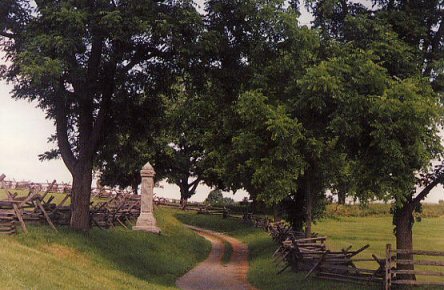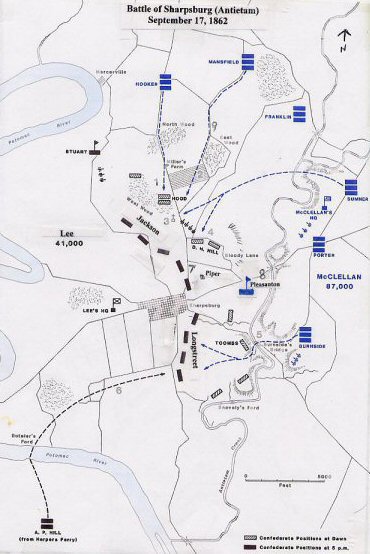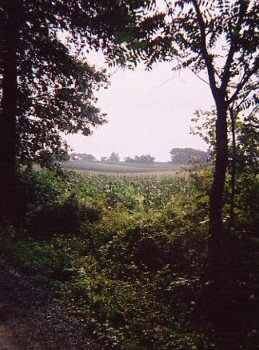|
Longstreet at Antietam : Profile of a
Commander
Nicholas E. Hollis
(All Rights Reserved)
The Battle of Sharpsburg (Antietam) marked
the end of CSA General Robert E. Lee’s first invasion of Maryland
(September 1862). The epic clash pitted a heavily outnumbered Army of
Northern Virginia (ANV) of 41,000—arrayed in strong defensive
position—against the Union Army of the Potomac (AP) of nearly 87,000 under
the command of Major General George McClellan.
Cornered with his back against the Potomac
River, Lee had turned his army to face the pursuing Federals, positioning
the ANV’s first corps on the right/center under Major General James
Longstreet on the hills above Sharpsburg and Antietam Creek, with ANV’s
Second Corps, under Major General Thomas “Stonewall” Jackson, on the left
across Hagerstown Pike, partially concealed by woods near a cornfield and
an old German church. ANV’s cavalry, under Major General J.E.B. Stuart,
held the far left.
Deadly September Showdown
The bloodiest day in America
history (September 17) began with furious, yet uncoordinated Union attacks
on the ANV left. The Union First Corps under General “Fighting Joe”
Hooker, delivered the initial assault at dawn, pushing Jackson’s brigades
back, but then stalled as ANV Major General John Bell Hood’s Texas
brigades counterattacked savagely (1). The AP Twelfth Corps under Major
General Joseph Mansfield attacked next through a cornfield at 7:30 a.m.,
capturing the Dunkard Church (2) — followed by a third massive Union drive
led by Major General Edwin Sumner’s Second Corps which slammed into the
struggle around Dunkard Church (3) and also pummeled the center of the ANV
line held by General D.H. Hill’s division along a sunken road (4) several
hundred yards away from Longstreet’s headquarters at Piper House.
Although there were many heroics on the
field on both sides, climaxed by the late afternoon arrival of A.P. Hill’s
brigades from Harper’s Ferry (6) in time to flank and check a broad Union
offensive on the right led by Union General Ambrose Burnside (5), the
actions of James Longstreet at the center deserve special attention. Lee
certainly thought so. As dusk settled on the bloody stalemate, and his
unit commanders gathered to assess their precarious situation, Lee saw the
melancholy and fatigue of near defeat in their eyes. But when Longstreet
rode up, Lee approached him as he dismounted , and with apparent
exuberance, clasped his shoulders with his hands, exclaiming “Ah, here is
General Longstreet, my old war horse. Let us hear what he has to say”.
A Thin Gray Line
In fact, Old Pete’s rugged
courage and steady performance at the front that day was the stuff of
legends. At the center of the rebel position, during the apex of Sumner’s
assault, Longstreet observed General Richardson’s division (AP) swinging
his line up along the crest of the hill (7) overlooking Piper House
(Longstreet’s field headquarters). The advance threatened to divide the
ANV’s position and rout the Confederates. But as the Federals swarmed over
“Bloody Lane”, moving toward the higher ground, Longstreet used his
presence to inspire his men and bolster the firing line, ordering his
staff officers to man an artillery battery and fire canister into the
advancing Federals. The rebel line was only fragmentary, but with shells
bursting around him, Old Pete calmly held the reins of his men's horses,
while surveying the desperate situation with his field glasses. He
remained mounted, if somewhat inelegant—with a slipper on an injured
foot—but his men were awestruck at his confident, imperturbable demeanor.
Moxley Sorrel, an aide, called him “magnificent”. When pressed by one of
his subordinates for help, Longstreet penned a short note,
“ I am sending you
the guns, dear General (Pryor). This
is a hard fight, and we had best all die than
lose it.”
|

(Photo courtesy of Paul Breitenbach) |
BLOODY
LANE--Rebel troops held off Federal attacks for nearly three and a
half hours along this sunken road, before being dislodged by B-G
Israel B. Richardson’s division.

|
The Fog of Battle
For the Union commanders facing
the ANV center there was no way to determine the depth of Confederate
troop strength behind the crest of the rolling hills. Could it be another
death trap like the Battle of Second Manassas a few weeks before or even
the as the West Woods had become earlier that same day? Union Cavalry
General Alfred Pleasanton (8) had orders to reinforce Richardson’s assault
and General Porter’s Fifth Corps was readied to deliver a crushing blow.
But the attack never came. Longstreet’s canisters and a demonstration move
by D.H. Hill fooled a Union command already in some disarray after both
Richardson, and his gallant Colonel Francis Barlow of New York, fell in
quick succession leading the advance.
Earlier that morning General Pleasanton had
dispatched one of his mounted companies (12th Pennsylvania)
under Major James A. Congdon, forward to the far right of the Union line
to monitor their rebel counterparts under Stuart. The detached unit was
posted off Hagerstown Pike (see diagram) on Poffenberger Lane (9) near the
East Woods for “provost duty” (herding stragglers, guarding prisoners) At
this position Congdon’s men, including
Pvt. Calvin W. Jennings, a nineteen
year old farm boy with a bugle, witnessed the carnage of the cornfield –
some of the heaviest fighting of the war. Thousands fell in the neat rows
of blood spattered corn, and whole units were practically decimated with
neither side holding clear advantage.
 |
Sources: National Park Service/Antietam -- Unit
Placement. William J. Clipson--Cartography.

|
A Captured Battle Flag
At one point after fresh Ohio
units slammed into the 6th and 27th Georgia
regiments, and the 4th Texas of General Hood’s division, Major
Congdon stopped and questioned an enlisted soldier carrying a captured
rebel battle flag toward the rear. When the flag’s identity could not be
determined, Congdon asked one of his new prisoners, Lt. William E. Barry
of G Company, 4th Texas, if he knew the flag. With great
emotion, Barry told his captors that the flag belonged to the First
Texas—a unit which had sustained heavy casualties, losing 182 out of 226
actives within a few minutes.2/
As bugler, posted near his commander,
Calvin Jennings probably witnessed the poignant moment, aware that some of
his Jennings relatives were fighting under ANV banners.
 |
VIEW FROM
EAST WOODS--Union troops could glimpse the battle, across the
cornfields and the West Woods. This present day photo looking west
from Poffenberger Lane near spot where the Twelfth Pennsylvania
Cavalry was posted on the morning of September 17, 1862.

|
Aftermath
Lee retreated across the Potomac into Virginia the following
night, his Maryland gamble lost, and later President Abraham Lincoln
sacked General McClellan for failing to press the attack. Lincoln would
also use Antietam to promulgate the Emancipation Proclamation giving new
inspiration to the Union cause. In Richmond, the near disaster of the
Maryland campaign prompted a reorganization of the Confederate army. Lee
remained in firm command, but on October 9, 1862 he chose Longstreet as
his chief lieutenant, elevating him to Lt. General of the ANV’s First
Corps. The next day commissions were signed for six other generals, ranked
as lieutenant generals, including Thomas “Stonewall” Jackson, who was
placed in command of ANV’s Second Corps.
Antietam proved decisive
in other ways. Southern momentum, generated from a string of victories,
including Second Manassas in late August, was checked – and the potential
of foreign diplomatic recognition for the Confederacy as a sovereign
nation (likely with a CSA victory) faded. The sheer carnage of America’s
deadliest day had a profound impact on the country’s psyche – particularly
after Matthew Brady’s photographs became public. More than 3,650 Americans
had been killed on that September day in 1862 (2,100 Union, 1,550 CSA),
with over 17,000 wounded. A hundred forty years later, after the horrors
of September 11, 2001, comparisons would be made between Antietam, Pearl
Harbor, Omaha Beach (Normandy), and the World Trade Center towers.. But
the Battle of Sharpsburg stands apart with searing impact, as it reflected
the mounting losses of the larger Civil War – a tragic “family dispute”
out of control, with brothers-in-arms warring on each other, whose long
shadow still haunts us today.
Notes and Additional
Reading
1/ Landscape Turned
Red: Battle of Antietam, Stephen Sears, (1983) p.276
2/
Antietam: A Soldiers’ Battle, John Michael Priest, (1989), p. 89
Leather and Steel: The
12th Pennsylvania Cavalry in the Civil War, Larry B. Maier,
(2001)
The Gleam of Bayonets:
The Battle of Antietam and Robert E. Lee’s Maryland Campaign,
September 1862, James V. Murfin, (1965)
Manassas to
Appomattox, James Longstreet, (1895), p.250-252 Enlist
in the campaign to restore Longstreet's honor!

Enrollment
Form
Contribution
Form General
Longstreet Recognition Project
Home |



